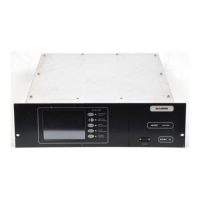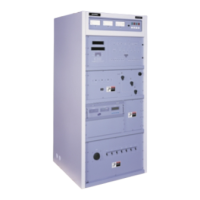Section N
External Interface (A28)
N.1 Introduction
This section describes the External Interface, and includes trou-
bleshooting information.
The External Interface provides an interface between the trans-
mitter control circuitry and any external control or monitoring
equipment, including remote control equipment and extended
control and monitoring panels. Interface circuits on the board
provide isolation between the Controller and any connections
made at TB1 and TB2. Diodes and transzorbs protect the trans-
mitter from transient and improper voltages accidentally placed
on external interface terminals.
The External Interface is located in the Center Control Compart-
ment. External Interface terminal boards TB1 and TB2 are lo-
cated just above the External Interface and are connected to the
board with ribbon cables.
N.2 Principles Of Operation
Interface circuits include opto-isolated control inputs, analog
voltage “monitor” outputs, open-collector “status” outputs, and
resistive voltage dividersfor external monitoring of Low Voltage
Power Supply voltages. Terminal board TB3 provides audio
input connections, and bipolar zener diodes for protection
against transient voltages.
Zener diode regulators on the board provide +15 VDC and -15
VDC to operate IC’s on the board. Three-terminal regulators
provide +15 VDC at 175 mA and -15 VDC at 175 MA for
customer use when either relay contacts or open-collector tran-
sistor outputs are used as remote control inputs.
All front-panel meter readings, ColorStat™ panel status indica-
tions, and control functions (except the Remote/Local switch)
are available at the External Interface.
Analogvoltagesamples aresetatapproximately+3.4VDCwhen
normal meter readings are present. This allows for high excur-
sions in readings while still remaining under the 4-Volt limit of
some currently available microprocessor-based remote control
equipment.
N.3 Circuit Description
Refer to the External Interface Schematic, 839-7855-090, in the
Drawing Package. Sheets 1 and 2 are schematic diagrams of all
circuits on the printed circuit board. Sheet 3 provides application
information and reference information, including simplified dia-
grams of each type of interface circuit, and interface circuit
connections for all terminals on TB1 and TB2. In addition,
terminal numbers and functions for TB1 and TB2 are silk
screened on the inside of the Driver Compartment door.
Each TYPE of interface circuit is described in the following
paragraphs. Sheet three of the schematic diagram provides a
summary of information for each type of interface circuit, in the
“Characteristic Key.” The “Type” for each description refers to
thedesignations(A,B,C,D,E,F,G)intheCharacteristicKey.
Additional figures in this section also provide information on
typical applications.
N.3.1
Status Outputs (Type A)
Refer to Sheet 3 of the External Interface Schematic Diagram.
Each status output is an open-collector output. When the action
described by the name of the signal at that status output is active,
the transistor will be turned on (saturated) and provide a current
sink to ground for a positive voltage applied at that input. All
Status Output transistors return to ground. Examples include:
a. “LOWER” Indicator: When the “LOWER” button on the
transmitter is illuminated, the transistor between TB1 ter-
minal 15 and ground is “ON”.
b. “LOW” Indicator: When the LOW power button on the
transmitter is illuminated, indicating that the transmitter is
in the LOW power mode, the transistor between TB1
terminal 20 and ground is “ON”.
c. “Supply Current Overload” indicator: When the “Supply
Current” overload indicator on the ColorStat™ panel is
RED, indicating a supply current overload, the transistor
between TB2 terminal 25 and ground is “ON”.
N.3.1.1 Status Output Protection
Status outputs are protected against reverse voltage by a diode
connected between the transistor collector and ground, with the
diode’s anode at ground. This protective diode will conduct if a
negative voltage is connected at the Status Output terminal on
TB1 or TB2.
Status outputs are also protected against excessive voltageinputs
at the Status Output terminal by a diode connected between the
transistorandthe+22 VDC unregulatedsupply.Acapacitorfrom
the transistor to ground provides bypassing for transient and RF
currents.
Refer the notes for Characteristic Key A on Sheet 3 of the
Schematic Diagram for additional information on Status Out-
puts, including current and voltage limitations.
N.3.1.2 Using Status Outputs
Refer to Figure N-1 for two possible output configurations.
N.3.2
Control Inputs (Type B)
All extended control inputs (remote control inputs) are optically
isolated. Both sides of the input are isolated from ground, to
allow flexibility in external input control circuits.
For each control input, both sides of the input terminals on TB1
or TB2 are isolated from ground and labeled (+) and (-).
12-12-94 888-2297-002 N-1
WARNING: Disconnect primary power prior to servicing.
